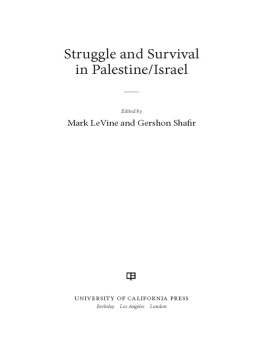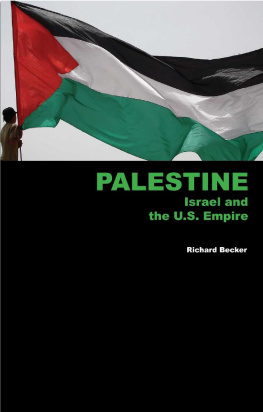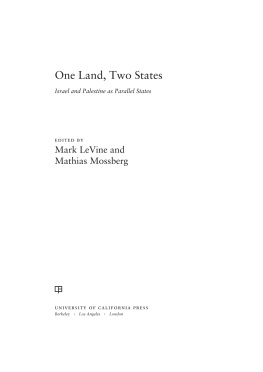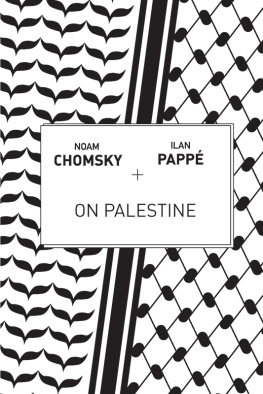LeVine Mark Andrew - Struggle and Survival in Palestine/Israel
Here you can read online LeVine Mark Andrew - Struggle and Survival in Palestine/Israel full text of the book (entire story) in english for free. Download pdf and epub, get meaning, cover and reviews about this ebook. year: 2012, publisher: University of California Press, genre: Home and family. Description of the work, (preface) as well as reviews are available. Best literature library LitArk.com created for fans of good reading and offers a wide selection of genres:
Romance novel
Science fiction
Adventure
Detective
Science
History
Home and family
Prose
Art
Politics
Computer
Non-fiction
Religion
Business
Children
Humor
Choose a favorite category and find really read worthwhile books. Enjoy immersion in the world of imagination, feel the emotions of the characters or learn something new for yourself, make an fascinating discovery.
- Book:Struggle and Survival in Palestine/Israel
- Author:
- Publisher:University of California Press
- Genre:
- Year:2012
- Rating:4 / 5
- Favourites:Add to favourites
- Your mark:
- 80
- 1
- 2
- 3
- 4
- 5
Struggle and Survival in Palestine/Israel: summary, description and annotation
We offer to read an annotation, description, summary or preface (depends on what the author of the book "Struggle and Survival in Palestine/Israel" wrote himself). If you haven't found the necessary information about the book — write in the comments, we will try to find it.
Struggle and Survival in Palestine/Israel — read online for free the complete book (whole text) full work
Below is the text of the book, divided by pages. System saving the place of the last page read, allows you to conveniently read the book "Struggle and Survival in Palestine/Israel" online for free, without having to search again every time where you left off. Put a bookmark, and you can go to the page where you finished reading at any time.
Font size:
Interval:
Bookmark:
Left Naked on the Beach
The Villagers of Aylut in the Grip of the New Templers
Mahmoud Yazbak
The village of Aylut is five kilometers to the northwest of the city of Nazareth. Most of the houses in the village are on a small hill and near the village bayader (threshing floors). Victor Guerin, who visited Aylut in 1876, estimated its population at two hundred people. In 1886, Gottlieb Schumacher put the figure at 350. The members of the British-based Palestine Exploration Fund described Aylut in 1881 as a small village in the woods. Travelogues and journals penned by European pilgrims who toured Palestine in the nineteenth century, as part of a growing movement of interest in the Holy Land, on the whole lack references to Aylut, perhaps because no remnants of a possible Jewish or Christian history had ever come to light there. Guerin, though, in a passing remark, mentions five sections of limestone pillars lying close to the walli's maqam, which he thought could have belonged to an old church.
The walli's maqam to which Guerin referred still stands in Aylut. People call it the Shrine and Tomb of the Prophet Lot (Lut) and believe the name of the village to be derived from the name of the prophet. Others suggest that Aylut is Syriac in origin and means summit. In reports by the Palestine Exploration Fund, the village's name is seen as a corruption of the Arabic word Alit, a species of tree.
The main landmark of the Shrine of the Prophet Lot is a tomb that was later incorporated into the village's small mosque compound. The tomb represented a holy site for the local people, who believed that the person buried there had special powers to fulfill their prayers and requests. Close to the shrine, there is a spring known as the Fountain of the Prophet Lot, whose waters flow copiously through the center of the village and border the bayader. The latter comprises a large, flat area of land, the village square, which, besides its agricultural function, acted as the main meeting point for the villagers throughout the year and was where they held their festivals, in particular wedding celebrations. As in other villages, a large oak tree stands in the middle for people to enjoy its shade on hot summer days. Over time the tree too became sacred, and local people placed lights in its branches twice a week, on Mondays and Thursdays, to drive evil spirits from the village.
In the nineteenth century, the Ottoman state granted families in Aylut the right to cultivate large areas of arable land extending some six to seven kilometers to the west of the village. The land included parts of the fertile plains of Marj Ibn Amir (the Jezreel Valley) and was divided into feddans (areas of about one acre each). In 1902, the area comprised eighteen such tracts, which the village's twenty-one families cultivated communally. The main crops they produced were wheat, barley, sesame, kirsanna (a kind of vetch), and various species of legumes, including beans, chickpeas, and lentils. Lands lying alongside the built-up area of the village were used for growing vegetables and irrigated with water from the village wells and fountains. The high-lying land surrounding the village was planted with several varieties of fruit trees, including some 250 dunams (a unit of land equal to one thousand square meters) of olive groves. The surrounding hills also provided the pasture for the village, which, like other Palestinian villages at the time, was bounded on all sides by sabir (cactus) that kept wild animals out.
In 1869, the Ottoman government allowed a family from Beirut by the name of Sursuq to purchase full ownership rights to twenty-two villages in Marj Ibn Amir, including several areas of agricultural land surrounding Nazareth. This followed the Ottoman Land Law of 1859, which freed state lands for sale to individual Ottoman citizens, partly in an effort to raise badly needed revenue for the state's treasury. In total, the Sursuq brothersNiqula, Najib, and Iskandaracquired 230,000 dunams of land in the area. The Sursuqs were a new breed of capitalists to this part of the world, for whom the land and the fellahin (the country's peasant farmers), who had cultivated it for centuries, were mere tools to make an easy profit. The new owners used the local fellahin, as well as fellahin they brought in from other areas, to cultivate the vast stretch of land, but now as hired farm laborers. The Sursuqs provided them with more modern agricultural implements and appointed urban merchants as agents to manage the villages. That they themselves held only usufruct but no ownership rights to the land made little difference in the minds of the local fellahin, since, as in time immemorial, they were allowed to remain on the land and continued to make a living from it. Thus they did not fully grasp the dramatic shift in their situation when proprietorship of the land passed from the state to the Sursuqs. However, once a capitalist landowner was no longer in need of the fellahin to work his land, their situation stood to deteriorate dramatically. Additionally, the 1859 Ottoman Land Law entitled the new owners to dispose of their land to whomever they pleased, and as their main interest was profit, they were not likely to show much regard for the plight of the peasants.
As was the case in many other Palestinian villages, the people of Aylut slowly became victims of the high-interest loans they had to take out from an expending stratum of moneylendersin the case of Aylut, the Sursuqs themselves. The preferred form of collateral for the loans was land, and when the fellahin were no longer able to meet the repayments, they effectively became hostages of the moneylender, who would await an opportune moment to use his credit as a means of appropriating their land.
For the people of Aylut this moment came in 1902. From then onward, they found themselves forced into waging a protracted and desperate struggle against displacement. In 1902, without prior notice, the Sursuq brothers served a lawsuit against the people of Aylut in the Nazareth Commercial Court for allegedly defaulting on the payment of their accumulated debts. The Sursuq brothers orderly records and standing in society convinced the court to rule in their favor against the fellahin. Indeed, the court not only ordered the fellahin to pay off the arrears immediately but also ruled that in case they failed to do so, the Sursuqs were entitled to confiscate from them a piece of arable land equal in value to the sum of their debts. In court, the people of Aylut vehemently protested that the loss of their land made them feel like they had been left naked on the beach.
ENTER THE GERMAN TEMPLERS
The Ayluti fellahin could not fathom why the patience of Najib Sursuq had suddenly come to an end, or why he had refused to pay the werko (state land tax) on their behalf, as he had always done until now according to the provisions of an annually renewed loan. They were also at a loss to understand why he had insisted on confiscating their arable lands as repayment for his loans. Answers to these questions have surfaced a century later in the form of a file of documents discovered in the German consulate in Haifa and housed in the Israel State Archives. The file contains, among other papers, documents relating to the Aylut-Sursuq case that form part of a separate lawsuit filed against the people of Aylut in 1903 by a certain Hans Keller, a German merchant living in Haifa's German Colony, with the active intervention of his brother, Friedrich (Fritz) Keller, at the time the German vice-consul in Haifa and Acre. The two lawsuits, of Keller and the Sursuqs, throw into sharp relief European colonizing endeavors in Palestine and the displacement and dispossession these spelled for the indigenous population.
As early as 1870, the Sursuqs initiated a procedure to rent out the village of Sammuniyya, located on arable lands in Marj Ibn Amir, to German settlers from the newly established German Colony in Haifa. The Germans belonged to a millenarian movement called the Templers, who originated in Wrttemberg and began arriving in Palestine, the Holy Land, in the early 1860s. The German settlers wished to establish agricultural colonies in Palestine, and renting the land was a first step toward purchasing it outright. Notables from Nazarethlocal landowners and cereal merchantsand the fellahin who lived off the land raised a protest and secured the intervention of the local authorities, the
Next pageFont size:
Interval:
Bookmark:
Similar books «Struggle and Survival in Palestine/Israel»
Look at similar books to Struggle and Survival in Palestine/Israel. We have selected literature similar in name and meaning in the hope of providing readers with more options to find new, interesting, not yet read works.
Discussion, reviews of the book Struggle and Survival in Palestine/Israel and just readers' own opinions. Leave your comments, write what you think about the work, its meaning or the main characters. Specify what exactly you liked and what you didn't like, and why you think so.










